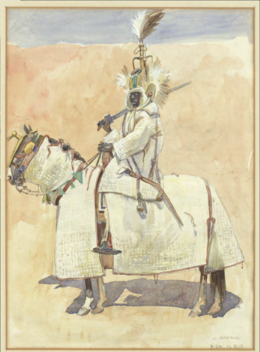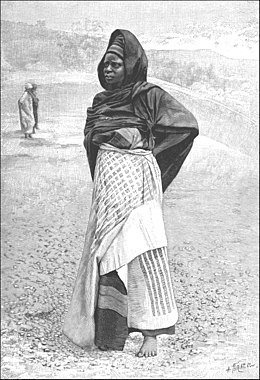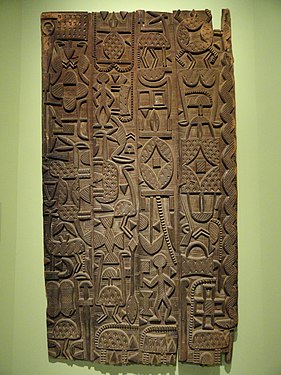Nupe people
Traditional African religion | |
| Related ethnic groups | |
|---|---|
| Gbagyi, Igala, Yoruba, Ebira, Kambari, Kamuku, Bariba, Dukawa |
The Nupe (traditionally called the Nupawa by the
History
The Nupe trace their origin to
Population and demography
There are probably about 4.5 million Nupes,

Traditions, art and culture
The Nupe people have various traditions. Many practices have changed as a result of the movements started by
Their art is often abstract. They are well known for their wooden stools with patterns carved onto the surface.[12][13]
The Nupe were described in detail by the ethnographer
Examples of Nupe art
-
Burtu wooden mask, used during bird hunting;Museum of Ethnology, Vienna. The hunter would tie the mask around his head and imitate the bird's movement.
-
Carved door; c. 1920 – 1940; wood with iron staples; Hood Museum of Art.
-
Wooden oval stool with incised carving; Los Angeles County Museum of Art.
Music and entertainment industry

Nupe traditional music is sung by the Ningba, or musician(s), while the Enyanicizhi beats the drum. Legendary Nupe singers of memory include Hajiya Fatima Lolo[14] Alhaji Nda'asabe, Hajiya Nnadzwa, Hauwa Kulu, Baba-Mini, Ahmed Shata and Ndako Kutigi.
The prime-movers of the Nupe cinema started film-making since the late 1990s into the early 2000s. Great Nupe personalities that birthed the idea of producing, acting and directing Nupe dramas/comedies on-screen are late Sadisu Muhammad DGN,
Notable Nupe people

- Shaikh Ahmad Lemu (OON, OFR) (1929–2020), Islamic scholar
- Hon. Justice Idris Legbo Kutigi (OFR, GCON) (1939–2018), Nigerian lawyer and chief justice of the Supreme Court of Nigeria
- Mohammed Umar Bago (born 1974), politician
- Muhammad Bima Enagi (born 1959), politician
- Muhammad Umaru Ndagi, academic professor (born 1964)
- Shehu Ahmadu Musa (1935–2008), politician
- Dangana Ndayako, politician and Senator in the Third Nigerian Republic
- Shaaba Lafiaji, politician
- Suleiman Takuma, journalist and political leader (1934–2001)
- Sam Nda-Isaiah (1962–2020), political columnist
- Jerry Gana, scholar and politician. See cabinet of Olusegun Obasanjo
- Isa Mohammed Bagudu (born 1948), third republic politician
- Zainab Kure(born 1959), politician
- Abdulkadir Kure (1956–2017), politician and former Governor of Niger State in the Fourth Nigerian Republic
- Aliyu Makama (1905–1980), Northern acting premiere
- H.R.H. Alhaji Yahaya Abubakar (GCFR) (born 1952), Etsu-Nupe; traditional ruler
- Mamman Jiya Vatsa (1940–1986) , intellctual, military officer and former FCT minister
- Fatima Lolo (1891–1997), musician
References
- ^ "Nupe" (PDF). National African Language Resource Center. Retrieved 2021-10-04.
- ^ Umaru Ndagi, Muhammad (January 2012). "Muslims of Niger State: A Survey" (PDF). University of Oxford. Retrieved 13 April 2023.
- ^ "Nupe", Britannica.
- S2CID 240243198
- S2CID 158674479.
- S2CID 154712112.
- )
- OCLC 35809832.
- , 2001) (retrieved Jan. 20, 2024).
- ^ "AFRICA | 101 Last Tribes - Nupe people". www.101lasttribes.com. Retrieved 2023-02-18.
- OCLC 5021109.
- S2CID 240282086.
- OCLC 1061313933.
- OCLC 39524822.
- ^ "Nupe Film Industry".
- ^ "Nupe film industry is currently heading for the rocks – Yikangi". BluePrint. 9 February 2015.
- .
Sources
- Blench, R. M. (1984), "Islam among the Nupe." Muslim peoples. (edn 2), Boulder, Colorado: Westview Press.
- Forde, D. (1955), "The Nupe". pp. 17–52 in Peoples of the Niger-Benue Confluence. London: IAI.
- Ibrahim, Saidu (1992), The Nupe and their neighbours from the 14th century. Ibadan: Heinemann Educational Books.
- Madugu, George I. (1971), "The a construction in Nupe: Perfective, Stative, Causative or Instrumental". In Kim, C-W., & Stahlke, H., Papers in African Linguistics, I, pp. 81–100. Linguistic Research Institute, Champaign.
- Perani, J. M. (1977), Nupe crafts; the dynamics of change in nineteenth and twentieth century weaving and brassworking. Ph.D. Fine Arts, Indiana University.
- Stevens, P. (1966), Nupe woodcarving. Nigeria, 88:21–35.
- Yahaya, Mohammed Kuta, The Nupe People of Nigeria. Nigeria, 95:1–2



